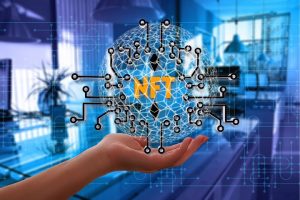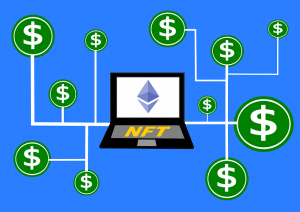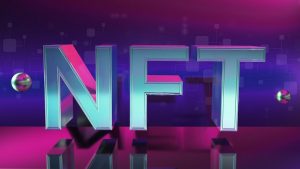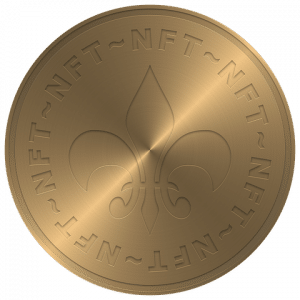Blockchain technology is rapidly progressing towards becoming mainstream with improvements in scaling, faster transaction processing speeds and decreasing costs. Nowhere will this progress be more apparent than in the field of non-fungible tokens (NFTs), 2019 being a breakthrough year for this type of object. Here we look at 10 important NFT trends that could change the world in 2022.

What is an NFT?
First of all, what is an NFT? According to our research, “NFT” stands for “Non-Fungible Token.” This means that each token is unique and not interchangeable with any other token.
Non-fungible tokens (NFTs) are an emerging technology that are revolutionizing the way we think about digital ownership.
NFTs use blockchain technology to record a unique, one-of-a-kind ownership of a digital item—like a piece of art, or even an in-game asset like a pair of sneakers—and they will soon be used to record more complex transactions like home loans and property deeds.
What would this mean in a practical sense? Imagine a world where you can become the owner of a digital object—and no one can take it away from you. Or imagine being able to represent your art or music digitally in a way that makes it impossible for someone to steal your work and claim it as their own. That’s what the NFT craze is all about: preserving ownership, authenticity, and artistry in a virtual world.
The benefits of NFTs are clear: they provide a safe and secure way for digital artists to profit from their work, for gamers to own rare items in games, and for people who want ownership of tangible assets but aren’t interested in the physical version themselves.
Related Article: NFT: What does NFT stand for? What does NFT mean?
We’ve done the research and here’s what we think will be the top 10 trends for NFTs in 2022:
1. Art and Music: Companies on platforms like Ethereum have shown that you can own digital works of art, music, or even memes as an NFT. This means that artists are able to create and sell their work online, with full confidence that their art won’t be stolen by someone else who claims they created it first.
2. NFTs may also be used to represent and manage real-world assets like property, art, music, jewelry and more. The use of smart contracts unlocks many possibilities here. Some companies are already offering NFT-based fractional ownership of the real estate, opening this up to a much larger investor base than was previously possible. This can also be applied to other assets including sports teams and classic cars.
3.NFTs can be used to give people ownership over their personal data and information, which is not currently possible with traditional online technologies such as cookies or similar methods of tracking.
4. NFTs will be used to create virtual goods. Instead of buying actual products with your money, you’ll be able to use NFTs as a virtual currency in order to purchase things like video games or movies from online stores like Steam or Amazon Prime.
5. NFTs will be used to create digital goods. In the same way that NFTs can be used for virtual goods, they can also be used to buy digital goods such as music downloads or e-books through services like iTunes or Google Play Music.
6. NFTs will become a primary form of online payment for digital goods and services. In the pre-NFT era, paying for something online was simple: you either paid in fiat or crypto. With NFTs, it’s easier to track where your money goes and to whom it belongs. This means that buying digital goods will become much more transparent and secure than before.
7.NFTs will become a key element in building social media profiles. Nowadays, people are obsessed with their social media profiles – they want them to look impressive and unique. With the help of smart contracts, one can create unique websites based on NFTs which would be impossible to forge or duplicate by anyone else. As such, they could become an integral part of social media profiles as we know them today.
8. Fashion: Brands will tokenize their clothing line, allowing them to use their inventory more efficiently while avoiding waste by selling products directly to consumers in a P2P marketplace.
9. NFTs will be used to access various types of online services – they may be used as an entry ticket to an online event or as an access key to a private platform.
They may also be used as game tokens that can be used to play games or access features in games. They could also be used to provide access to premium content on any site.
10. Real Estate: Properties will be tokenized and sold on a blockchain, making it possible to own fractional shares of property or receive income from your investment without paying exorbitant fees or waiting for approval from the bank.
Related Article: NFTs: What is an NFT?: How does an NFT work

Section 2: Non-Fungible Tokens Will Trade on Exchanges
Non-fungible tokens will trade on exchanges. It is impossible not to notice the proliferation of non-fungible tokens (NFTs) over the last few months. From a $69 million Beeple auction to the $3.5 million sales of digital artwork by Pak, NFTs have become the hottest thing since sliced bread.
The hype around NFTs is still very much in its infancy, but there are signs that it could go mainstream this year. One such sign is that there is a growing effort to get NFTs listed on regulated cryptocurrency exchanges.
The first regulated exchange to list an NFT was Gemini back in July 2020 when they listed NBA Top Shots. In October 2020, crypto exchange FTX launched an NFT marketplace with support for fractionalized NFTs and derivatives trading. The following month, Bittrex Global became the first European-based exchange to begin listing NFTs for trading, starting with Neon District and Sorare. In February 2021, FTX launched its own branded collectibles called FTX Collectibles, based on the Ethereum blockchain and each one representing a class of cryptocurrency assets ranging from Bitcoin to Polkadot.
We can imagine that non-fungible tokens will trade on traditional exchanges.
There are solid reasons why traditional exchanges are interested in listing NFTs, including the following:
1. For one thing, a cryptocurrency exchange does not gain any revenue from NFTs, since it is not involved in buying and selling the actual digital asset.
2. Also, NFTs have a value that is independent of the price of any particular cryptocurrency. This means that there is no risk to the exchange when they are bought or sold. It also means that an exchange could make money by offering low fees for trading NFTs.
3. Most NFTs are used as tokenized assets in games and collectible markets. This represents a huge opportunity for investors and traders who want to make money from virtual assets.
4. Trading NFTs is cheaper for exchanges than trading cryptocurrencies or commodities. If a person sells an item (e.g., a baseball card), he or she pays sales tax on it. But if you sell an NFT instead of that same card, you might not have to pay tax at all because the IRS hasn’t determined how to treat NFT transactions yet.
5. Lastly, an exchange could benefit by providing liquidity to the market and attracting new users who may want to buy or sell tokens in bulk.

Section 3: Major Institutions Will Migrate to NFTs
In a professional tone: As the NFT boom continues, major institutions will continue to migrate over to the space. This is already happening with museums, musicians, and other artists, but with the recent announcement of the release of an NFT trading game by Atari and Animoca Brands, this phenomenon is sure to spread even further. This is an exciting development because it means that more people will be exposed to NFTs and learn about how they work. It also means that more tools will be created for the industry and more money will flow into it overall.
Section 4: More Crypto Networks and Projects Will Integrate NFTs
NFTs are becoming more popular as a way to prove ownership of digital assets. Given the growing interest in NFTs, we believe that more crypto networks and projects will integrate them into their ecosystems.
The growing use of NFTs across a variety of networks and platforms indicates that this trend will likely continue.
A popular example is the growth of NFTs on the Binance Smart Chain, where the total value locked in NFTs has grown significantly over the past few months. This suggests that there’s a demand for NFTs on smart contract platforms outside of Ethereum, and many other networks are looking to capitalize on this.
NFT issuance platforms like Mintbase are also helping to make NFT issuance more accessible to a broader audience. These types of platforms allow users to create their own Ethereum-based ERC-20 tokens, which can then be used for a variety of purposes – including as tradable digital collectibles.
As more artists, musicians, athletes, and other content creators look to move into the digital goods space, it’s possible that we’ll see many more non-fungible tokens being created in the future.
Section 5: NFTs Are Heralding an Era of Data Ownership
The arrival of non-fungible tokens (NFTs) is ushering in a new age of data ownership. NFTs are being used to create digital scarcity, which offers an opportunity for people to certify that they own their own data and to monetize it. As these tokens become more commonplace, they’ll be a game-changer for the future of the digital market.
Let’s start at the beginning: What are NFTs? They’re unique blockchain-based digital tokens that can be “minted” using various platforms like Ethereum, Bitcoin, and EOS. These tokens represent something that cannot be easily replaced by another asset—like a piece of art or a rare item in a video game—which means that there’s no way to substitute one NFT for another when making a transaction. This creates “digital scarcity,” which plays an important role in the value of NFTs.
Digital scarcity means that artists can now prove ownership of their work and offer it directly to collectors, who can now buy and sell verified works with confidence. As a result, artists have access to new revenue streams, and collectors can feel secure about their purchases.
NFTs are helping to usher in the next stage of our relationship with data. People can now own pieces of data and information generated by them through NFTs. In other words, NFTs are creating data ownership, which is transforming how we use the internet.
Section 6: Virtual Worlds and Video Games Unlock NFTs
Virtual worlds and video games are one of the most popular use cases for non-fungible tokens (NFTs). They allow players to buy, sell, and trade collectibles, access virtual land, and earn real money for their game accomplishments.
The possibilities for NFTs in gaming are endless. There is no limit to how many unique items can be minted, which means there is a wide range of items gamers can collect and trade. Some games even allow players to create their own NFTs, which they can then sell on the marketplace.

Section 7: NFTs will increase the value of digital assets
Non-fungible tokens, which have recently been used to create a digital marketplace for the sale of unique digital assets, are expected to exponentially increase the value of digital art and other one-of-a-kind digital goods.
Whereas digital assets have traditionally been considered valuable only for their utility—for example, the fact that a digital painting can be viewed onscreen—the advent of NFTs is allowing them to be collected and traded as unique, one-of-a-kind items. This is causing these assets to become increasingly valuable in their own right, as they’re now able to take part in a previously untapped market of buyers who are interested in collecting them as works of art or novelties.
In this way, NFTs are opening a new world of possibilities for artists and creators everywhere.
NFTs (non-fungible tokens) are unique digital assets that represent ownership rights to a digital asset, such as a piece of art. NFTs are created using a smart contract on the Ethereum blockchain. The smart contract ensures that only one person can own the digital asset at a time and also manages the transaction process when the asset is sold or exchanged.
NFTs have already started to change the way people own and trade digital assets. NFTs allow users to purchase or sell specific pieces of art and other digital objects without having to transfer ownership of their entire “library” of assets. This gives NFT owners more options for how they choose to use their assets, which increases both the value of their assets and their enjoyment in owning them!
NFTs have the potential to increase the value of digital assets greatly. They create a way for users to invest in virtual worlds and apps with real-world value, making it more likely that these apps will succeed by providing an easy way for users to buy into them.
